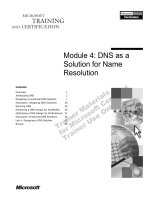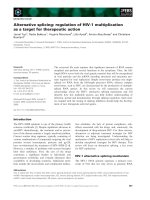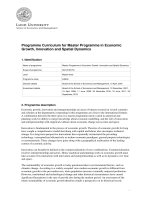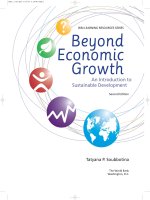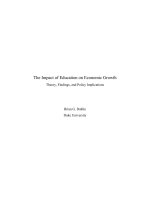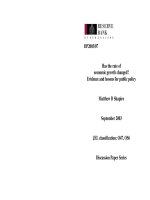Competitiveness as an Engine for Economic Growth: Implications for Saudi Arabia doc
Bạn đang xem bản rút gọn của tài liệu. Xem và tải ngay bản đầy đủ của tài liệu tại đây (549.95 KB, 41 trang )
1
Copyright 2008 © Professor Michael E. PorterCompetitiveness Master = 2007-11-14.ppt
Competitiveness as an
Engine for Economic Growth:
Implications for Saudi Arabia
Professor Michael E. Porter
Harvard Business School
The Global Competitiveness Forum 2008
January 21, 2008
This presentation draws on ideas from Professor Porter’s articles and books, in particular, The Competitive Advantage of Nations (The Free Press, 1990),
“Building the Microeconomic Foundations of Competitiveness,” in The Global Competitiveness Report 2006
(World Economic Forum, 2006), “Clusters and
the New Competitive Agenda for Companies and Governments” in On Competition
(Harvard Business School Press, 1998), and ongoing research on
clusters and competitiveness. No part of this publication may be reproduced, stored in a retrieval system, or transmitted in any form or by any means -
electronic, mechanical, photocopying, recording, or otherwise - without the permission of Michael E. Porter. Further information on Professor Porter’s work
and the Institute for Strategy and Competitiveness is available at www.isc.hbs.edu
Version: January 18, 2008, 4pm
2
Copyright 2008 © Professor Michael E. PorterCompetitiveness Master = 2007-11-14.ppt
Saudi Arabia’s Competitive Position in 2008
• The dramatic increase in oil prices has created significant resources
and rapid growth for the Saudi economy
• There is a new level of determination to leverage this opportunity to
build a truly competitive economy and diversify beyond natural
resources
• Saudi Arabia can succeed on this path, but only if it is willing to take a
strategic approach, make multiple improvements in its business
environment, truly open up competition and entrepreneurship in the
private sector, and embark on a sustained effort to equip Saudi citizens
with new skills, attitudes and mindsets
• It will be easy to become impatient and distracted by near term
economic growth and the ability to support uncompetitive practices and
policies
3
Copyright 2008 © Professor Michael E. PorterCompetitiveness Master = 2007-11-14.ppt
Saudi Arabia’s Long-Term Prosperity
GDP per Capita
CAGR: -6.1%
Source: Groningen Growth and Development Centre and The Conference Board (2007), Swivel (2007)
GDP per Capita
CAGR: +0.00%
GDP per Capita
CAGR: +1.4%
Index Values,
1980 = 1.00
4
Copyright 2008 © Professor Michael E. PorterCompetitiveness Master = 2007-11-14.ppt
$0
$5,000
$10,000
$15,000
$20,000
$25,000
$30,000
$35,000
$40,000
$45,000
$50,000
0% 1% 2% 3% 4% 5% 6% 7%
Prosperity Performance
Selected Countries
PPP-adjusted GDP
per Capita, 2006
Growth of Real GDP per Capita (PPP-adjusted), CAGR, 2001-2006
Source: EIU (2007), authors calculations
Ireland
USA
Hungary
China (9.49%)
Vietnam
Poland
Taiwan
Greece
Pakistan
Portugal
Switzerland
Norway
Czech Republic
Slovakia
Germany
Finland
Iceland
Sweden
Spain
UK
Netherlands
Denmark
France
Russia
SAUDI ARABIA
Turkey
Thailand
Chile
Singapore
Croatia
Philippines
Qatar
Slovenia
Belgium
Canada
Italy
Australia
Japan
Korea
Mexico
New Zealand
Brazil
India
Oman
Indonesia
Argentina
Hong Kong
Israel
Malaysia
South Africa
Austria
Iraq
(-6.2%)
Egypt
Iran
Yemen
Libya
Tunisia
Algeria
Kuwait
Bahrain
Lebanon
Jordan
United Arab Emirates
Syria
5
Copyright 2008 © Professor Michael E. PorterCompetitiveness Master = 2007-11-14.ppt
• Competitiveness is determined by the productivity with which a nation
uses its human, capital, and natural resources.
– Productivity sets the standard of living (wages, returns on capital, returns
on natural resources) that a country can sustain
– It is not what industries a nation competes in that matters for prosperity, but
how it competes in those industries
– Productivity in a national economy arises from a combination of domestic
and foreign firms
– The productivity of “local” or domestic industries is fundamental to
competitiveness, not just that of export industries
What is Competitiveness?
• Nations compete in offering the most productive environment for business
• The public and private sectors play different but interrelated roles in creating a
productive economy
6
Copyright 2008 © Professor Michael E. PorterCompetitiveness Master = 2007-11-14.ppt
Sources of Prosperity
Inherited Prosperity
Inherited Prosperity
• Prosperity is derived from selling or
exploiting inherited natural resources
• Prosperity is constrained
• Government is the central actor in the
economy as the owner and distributor of
resource wealth
– Resource revenues allow
unproductive policies and practices
to persist
• Government’s role gravitates towards the
distribution of wealth as interest groups
seek a bigger share of the pie
• Prosperity is derived from selling or
exploiting inherited natural resources
• Prosperity is constrained
• Government is the central actor in the
economy as the owner and distributor of
resource wealth
– Resource revenues allow
unproductive policies and practices
to persist
• Government’s role gravitates towards the
distribution of wealth as interest groups
seek a bigger share of the pie
Created Prosperity
Created Prosperity
• Prosperity is derived from creating
valuable products and services
• Prosperity is unlimited
• Companies are the central actors in the
economy
– Prosperity can only be created by
firms
• Government’s role is to create the
enabling conditions for productivity
and foster private sector development
• Prosperity is derived from creating
valuable products and services
• Prosperity is unlimited
• Companies are the central actors in the
economy
– Prosperity can only be created by
firms
• Government’s role is to create the
enabling conditions for productivity
and foster private sector development
7
Copyright 2008 © Professor Michael E. PorterCompetitiveness Master = 2007-11-14.ppt
0
10,000
20,000
30,000
40,000
50,000
60,000
70,000
80,000
90,000
100,000
-1.0% 0.0% 1.0% 2.0% 3.0% 4.0% 5.0%
Comparative Labor Productivity
Selected Countries
Compound annual growth rate (CAGR) of real GDP per employee (PPP-
adjusted), 2001-2006
GDP per employee
(PPP adjusted US$),
2006
Source: EIU (2007), Saudi Arabia employee data (number persons employed) from ILO LABORSTA (2007)
USA
Czech Republic
Portugal
Italy
Sweden
Netherlands
France
Slovakia
Germany
Greece
Spain
New Zealand
Ireland
Australia
Austria
Hungary
Finland
Canada
Denmark
Norway
Japan
UK
Turkey
(6.4%)
Poland
Mexico
Tunisia
Iran
Qatar
Israel
SAUDI ARABIA
Brazil
Algeria
Hong Kong
Taiwan
Singapore
India (5.3%)
China (9.0%)
South Africa
Slovenia
Malaysia
Egypt
Pakistan
Philippines
Indonesia
Vietnam
Thailand
Chile
Croatia
Belgium
8
Copyright 2008 © Professor Michael E. PorterCompetitiveness Master = 2007-11-14.ppt
Labor Force Mobilization
Selected Countries
Employees as % of
Population, 2006)
Note: Use most recent year available, either 2005 or 2006
Source: The Conference Board and Groningen Growth and Development Centre, Total Economy Database, November 2007
OECD average: 0.47
Middle East average: 0.40
9
Copyright 2008 © Professor Michael E. PorterCompetitiveness Master = 2007-11-14.ppt
Fixed Investment Rates
Selected CountriesGross Fixed Investment
as % of GDP (2006)
Source: EIU, 2007.
CAGR Gross Fixed Investment (as % of GDP), 1990 - 2006
Turkey
Indonesia
US
Morocco
Saudi Arabia
Bahrain
Lebanon
Yemen
Kuwait
Oman
Egypt
Pakistan
Algeria
Tunisia
Syria
Jordan
India
Iran
South Korea
China
Libya
Philippines
Qatar
Nigeria
Singapore
Brazil
UAE
10
Copyright 2008 © Professor Michael E. PorterCompetitiveness Master = 2007-11-14.ppt
Saudi Arabia’s Exports
Types of Goods and Services
Source: Institute for Strategy and Competitiveness – International Cluster Competitiveness Project; UN Comtrade; IMF BOP statistics.
Exports
($ Thousands)
Export Type
Value of Exports, 2006 Growth Rate of
Exports, CAGR
1998-2006
Natural Resources Related $201.2 Billion 24.0%
Non-Natural Resource Related $19.0 Billion 11.3%
Semi-Processed Natural Resources
$36.4 Billion
20.3% CAGR
Processed Goods
$11.7 Billion
16.9% CAGR
Services
$7.3 Billion
5.6% CAGR
11
Copyright 2008 © Professor Michael E. PorterCompetitiveness Master = 2007-11-14.ppt
Inward Foreign Direct Investment Stock
Source: WIR, 2007.
Saudi Arabia
Other countries
U.A.E.
Bahrain
Qatar
Share of Middle East
Inward FDI stock
12
Copyright 2008 © Professor Michael E. PorterCompetitiveness Master = 2007-11-14.ppt
Microeconomic Competitiveness
Quality of the
Microeconomic
Business
Environment
Sophistication
of Company
Operations and
Strategy
State of Cluster
Development
Determinants of Competitiveness
• A sound macroeconomic, political, legal, and social context create the potential for
competitiveness, but is not sufficient
• Competitiveness ultimately depends on improving the microeconomic capability
of the economy and the sophistication of local competition
Macroeconomic, Political, Legal, and Social Context
13
Copyright 2008 © Professor Michael E. PorterCompetitiveness Master = 2007-11-14.ppt
Macroeconomic, Political, Legal, and Social Context
• Saudi Arabia has registered sound macroeconomic policies, but
transparency remains limited and inflationary pressures are rising
• There are ongoing debates about direction and speed of political
reforms, which limits predictability and policy stability. Government
processes remain complex and have limited transparency
• The Saudi legal system is in the process of modernization, but
concerns remain about uncertainty in judicial decision making
• Social policies have addressed poverty and basic social needs, but
challenges arise in education, gender relations, and the large
expatriate community
14
Copyright 2008 © Professor Michael E. PorterCompetitiveness Master = 2007-11-14.ppt
Corruption Perception Index, 2007
Note: Ranks only countries available in both years (124 countries total)
Source: Global Corruption Report, 2007
Change in Rank, Global Corruption Report, 2007 versus 2003
Rank in
Global
Corruption
Index,
2007
124
1
Improving
Deteriorating
High
corruption
Low
corruption
United Arab Emirates
Indonesia
India
Qatar
Turkey
China
Brazil
Oman
Bahrain
SAUDI ARABIA
Russia
Jordan
Tunisia
Syria
Iraq
Nigeria
Algeria
Iran
Yemen
Pakistan
Libya
Venezuela
Ecuador
Angola
Belize
Trinidad & Tobago
15
Copyright 2008 © Professor Michael E. PorterCompetitiveness Master = 2007-11-14.ppt
Improving the Business Environment: The Diamond
Context for
Firm
Strategy
and Rivalry
Context for
Firm
Strategy
and Rivalry
Related and
Supporting
Industries
Related and
Supporting
Industries
Factor
(Input)
Conditions
Factor
(Input)
Conditions
Demand
Conditions
Demand
Conditions
z Access to high quality
business inputs
– Natural endowments
– Human resources
– Capital availability
– Physical infrastructure
– Administrative infrastructure
(e.g. registration, permitting)
– Information infrastructure
(e.g., transparency)
– Scientific and technological
infrastructure
z Availability of suppliers and
supporting industries
z Presence of clusters instead of
isolated firms
z Sophistication of local
customers and needs
–Strict quality, safety, and
environmental standards
• Successful economic development is a process of successive upgrading, in which the business
environment improves to enable increasingly sophisticated ways of competing
z Local rules and incentives
that encourage investment and
productivity
– e.g. salaries, incentives for
capital investments,
intellectual property protection
z Vigorous local competition
– Openness to foreign and local
competition
16
Copyright 2008 © Professor Michael E. PorterCompetitiveness Master = 2007-11-14.ppt
Ease of Doing Business
Saudi Arabia
Ranking, 2007 (of
178 countries)
Source: World Bank Doing Business (2008)
Favorable Unfavorable
Median Ranking,
Middle East
Saudi Arabia per capita GDP rank: 48
Saudi Arabia 2010 goal: 10
Saudi Arabia Doing Business rank: 23
17
Copyright 2008 © Professor Michael E. PorterCompetitiveness Master = 2007-11-14.ppt
Quality of electricity supply 40
Quality of port infrastructure 42
Air transport infrastructure quality 43
Reliability of police services 45
Competitive Disadvantages
Relative to GDP per Capita
Competitive Advantages
Relative to GDP per Capita
Stringency of environmental regulations 101
Business costs of corruption 89
Buyer sophistication 81
Quality of management schools 73
Quality of private property rights 72
Absence of trade barriers 69
Decentralization of economic policymaking 69
Local equity market access 65
Quality of math and science education 65
Local availability of specialized research 65
and training services
Quality of primary education 64
Financial market sophistication 63
Availability of scientists and engineers 57
Effectiveness of antitrust policy 57
Intensity of local competition 53
Quality of scientific research institutions 51
Saudi Arabian Business Environment
Selected Advantages and Disadvantages, 2007
Note: Rank versus 127 countries; overall, Saudi Arabia ranks 48
th
in 2006 PPP adjusted GDP per capita and 51
h
in Business Competitiveness. Only 2007 data available.
Source: Institute for Strategy and Competitiveness, Harvard University (2007)
18
Copyright 2008 © Professor Michael E. PorterCompetitiveness Master = 2007-11-14.ppt
SAUDI ARABIA
0
5,000
10,000
15,000
20,000
25,000
30,000
35,000
40,000
45,000
United States
Switzerland
Italy
Denmark
Ireland
India
Business Competitiveness Index
2006 GDP per Capita
(PPP- adjusted)
Malaysia
Source: Global Competitiveness Report 2007
Sweden
Kuwait
Finland
Germany
Qatar
Norway
HighLow
Greece
Argentina
Spain
Bahrain
Libya
Indonesia
Kenya
Tunisia
Korea
Colombia
Variation in BCI score
explains 82% of
variation in GDP per
capita
Ranking Microeconomic Competitiveness
Business Competitiveness Index, 2007
Iceland
Hong Kong
New Zealand
Estonia
Japan
Chile
Thailand
Costa Rica
Jordan
Russia
Venezuela
Hungary
Cyprus
Slovenia
Portugal
Israel
Taiwan
France
Australia
Latvia
Poland
Slovakia
Czech Republic
South Africa
China
Brazil
Tanzania
Nigeria
Pakistan
Philippines
Peru
Ukraine
Canada
Saudi Arabia’s Ranking
Global
Competitiveness
Index
Business
Competitiveness
Index
35 51
Lithuania
19
Copyright 2007 © Professor Michael E. PorterCompetitiveness Master = 2007-11-14.ppt
Sources: HBS student team research (2003) - Peter Tynan, Chai McConnell, Alexandra West, Jean Hayden
Hotels
Hotels
Attractions and
Activities
e.g., theme parks,
casinos, sports
Attractions and
Activities
e.g., theme parks,
casinos, sports
Airlines,
Cruise Ships
Airlines,
Cruise Ships
Travel agents
Travel agents
Tour operators
Tour operators
Restaurants
Restaurants
Property
Services
Property
Services
Maintenance
Services
Maintenance
Services
Government agencies
e.g. Australian Tourism Commission,
Great Barrier Reef Authority
Government agencies
e.g. Australian Tourism Commission,
Great Barrier Reef Authority
Educational Institutions
e.g. James Cook University,
Cairns College of TAFE
Educational Institutions
e.g. James Cook University,
Cairns College of TAFE
Industry Groups
e.g. Queensland Tourism
Industry Council
Industry Groups
e.g. Queensland Tourism
Industry Council
Food
Suppliers
Food
Suppliers
Public Relations &
Market Research
Services
Public Relations &
Market Research
Services
Local retail,
health care, and
other services
Local retail,
health care, and
other services
Souvenirs,
Duty Free
Souvenirs,
Duty Free
Banks,
Foreign
Exchange
Banks,
Foreign
Exchange
Local
Transportation
Local
Transportation
Enhancing Cluster Development
Tourism Cluster in Cairns, Australia
20
Copyright 2007 © Professor Michael E. PorterCompetitiveness Master = 2007-11-14.ppt
Equipment
Suppliers
(e.g. Oil Field
Chemicals,
Drilling Rigs,
Drill Tools)
Specialized
Technology
Services
(e.g. Drilling
Consultants,
Reservoir Services,
Laboratory Analysis)
Subcontractors
(e.g. Surveying,
Mud Logging,
Maintenance
Services)
Business
Services
(e.g. MIS Services,
Technology
Licenses,
Risk Management)
Specialized Institutions
(e.g. Academic Institutions, Training Centers, Industry Associations)
The Houston Oil and Gas Cluster
Oil & Natural Gas
Completion &
Production
Oil & Natural Gas
Exploration &
Development
Oil
Trans-
portation
Oil
Trading
Oil
Refining
Oil
Retail
Marketing
Oil
Wholesale
Marketing
Oil
Distribution
Gas
Gathering
Gas
Processing
Gas
Trading
Gas
Transmis-
sion
Gas
Distribution
Gas
Marketing
Upstream
Downstream
Oilfield Services/Engineering & Contracting Firms
21
Copyright 2007 © Professor Michael E. PorterCompetitiveness Master = 2007-11-14.ppt
National Cluster Export Portfolio
Saudi Arabia, 1997-2005
Change in Saudi Arabia’s world export market share, 1997 – 2005
Source: Prof. Michael E. Porter, International Cluster Competitiveness Project, Institute for Strategy and Competitiveness, Harvard Business
School; Richard Bryden, Project Director. Underlying data drawn from the UN Commodity Trade Statistics Database and the IMF BOP statistics.
Saudi Arabia’s world export market share, 2005
Change In Saudi
Arabia’s Overall World
Export Share: +1.09%
Saudi Arabia’s Average
World Export Share: 1.92%
Exports of US$1.2 Billion =
Processed Foods
Business Services
Chemical Products
Oil and Gas
(5.49%, 14.99%)
$162 billions
Plastics
Prefabricated Enclosures and Structures
2%
1.5%
1%
0.5%
Construction Materials
0%
Agricultural Products
Metal Mining and
Manufacturing
Motor Driven Products
Communications Equipment
Building Fixtures and Equipment
Jewelry, Precious Metals and Collectibles
Textiles
Leather and Related Products
Automotive / Medical Devices Biopharmaceuticals
22
Copyright 2007 © Professor Michael E. PorterCompetitiveness Master = 2007-11-14.ppt
Improving Company Sophistication
Relative Position of Saudi Arabian Companies, 2007
Extent of staff training 77
Reliance on professional management 71
Degree of customer orientation 69
Extent of marketing 68
Prevalence of foreign technology 62
licensing
Extent of regional sales 61
Extent of incentive compensation 56
Breadth of international markets 52
Capacity for innovation 49
Nature of competitive advantage 49
Willingness to delegate authority 47
Competitive Disadvantages
Relative to GDP per Capita
Competitive Advantages
Relative to GDP per Capita
Note: Rank versus 127 countries; overall, Saudi Arabia ranks 48
th
in 2006 PPP adjusted GDP per capita and 51
h
in Business Competitiveness. Only 2007 data available.
Source: Institute for Strategy and Competitiveness, Harvard University (2007)
Control of international distribution 19
Production process sophistication 32
Value chain breadth 34
23
Copyright 2007 © Professor Michael E. PorterCompetitiveness Master = 2007-11-14.ppt
Geographic Influences on Competitiveness
Broad Economic Areas
Broad Economic Areas
Groups of Neighboring
Nations
Groups of Neighboring
Nations
States, Provinces
States, Provinces
Metropolitan Areas
Metropolitan Areas
Nation
Nation
World Economy
World Economy
Rural Areas
Rural Areas
The Neighborhood
Regional Economies
24
Copyright 2007 © Professor Michael E. PorterCompetitiveness Master = 2007-11-14.ppt
Saudi Arabia’s Provinces
Source: Saudi Arabian Monetary Authority (SAMA) report, 2007
% Social Security recipients below/above national average
% Labor force participation above/below national average
25
Copyright 2007 © Professor Michael E. PorterCompetitiveness Master = 2007-11-14.ppt
The Neighborhood
Middle East
• Economic coordination among neighboring countries can significantly enhance competitiveness
• Integration with neighbors offers greater opportunities than participation in broader economic forums
